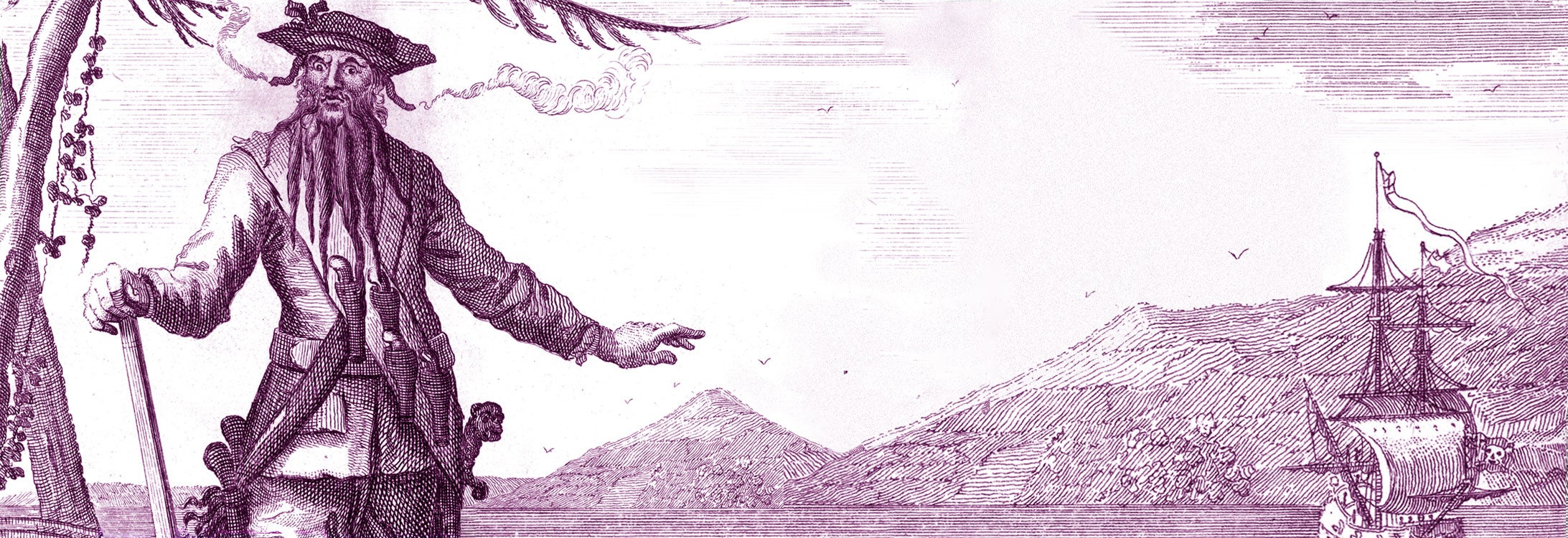INTENTIONAL SHIPWRECK?
New research from ECU suggests Blackbeard ran the QAR aground on purpose
It has long been speculated by historians that the notorious pirate Blackbeard may have intentionally run his ship, the Queen Anne’s Revenge (QAR), aground off the coast of North Carolina in 1718.
New research from East Carolina University’s Jeremy Borrelli supports this theory and suggests that Blackbeard may have indeed landed on the sand bar near Beaufort intentionally because the vessel was beyond repair.

A characteristic lead strip with two rows of fasteners, a slight crease down the centerline, and the remains of caulking material on one side.
(Contributed images)
Borrelli, a staff archaeologist in the Department of History’s Maritime Studies program, found the ship had major leaks that were repaired with lead sheathing by studying artifacts from the 300-year-old shipwreck.
His research, “An Initial Assessment of Lead Artefacts Used for Hull Repair and Maintenance on North Carolina Shipwreck 31CR314, Queen Anne’s Revenge (1718),” recently was published in the International Journal of Nautical Archaeology.

Photo and diagram of the starboard face of the QAR sternpost. Arrows and shaded areas indicate the location of lead sheathing.
Borrelli writes in his summary, “The grounding of QAR may therefore represent a premeditated move by Blackbeard to rid himself of a ship that he felt was no longer serviceable. Additional study of the wooden remains and associated features of the pirate flagship will undoubtedly reveal further information regarding the necessity for the added hull protection, and could also help to determine if the leaky state of the hull at the time of sinking was a factor in what was either a mistake or calculated maneuver on the part of one of history’s most infamous pirates.”
Borrelli’s research also appeared in the July 3 issue of New Scientist, a popular international publication that covers science and technology.
According to historical records, before Blackbeard’s acquisition of the QAR, previously known as La Concorde, the ship developed several major leaks during a privateering voyage to the Caribbean in 1711-1712.
To help repair the leaks, Borrelli said sheet lead was commonly kept on ships and could be cut to fit specific needs. He said his research article represents preliminary findings because only 60% of the QAR site has been recovered so far.
“What was most interesting about the examination of the artifacts, in my opinion, is the implications derived from the artifact evidence coupled with the historical record,” said Borrelli. “We know that the ship had documented cases of significant leaks forming in the hull prior to its capture by Blackbeard and his pirates. After it was captured, Blackbeard kept the pilot, two carpenters and the caulker from the French crew. These individuals would have a good working knowledge of the ship’s condition and so this decision to keep them makes sense to increase the longevity of the pirate’s newly acquired prize.”

a) Example of lead sheathing that appears to be shaped around the end of a hull timber, with one end torn and fasteners along the perimeter and diagonally across the plank face of the lead; b) close‐up of tool marks, likely made using a triangular gouge.
Lead sheathing served three roles on ships: to protect from marine infestations, to protect against wood-boring animals and insects, and to assist in waterproofing the hull.
“One of the most common sources for leaks on ships formed at the plank seams, where caulking could work loose from the torsional stresses on the ship as it passed through water,” Borrelli said. “Most of the lead sheathing artifacts on QAR are associated with this function of keeping the hull watertight by placing long strips of lead over the plank seam to protect and secure the caulking material. Re-caulking the ship was a major process, so these sheathing measures were used until the situation could no longer be ignored.”
Borrelli joined the ECU Maritime Studies program in 2018 as an assistant staff archaeologist, but was engaged in ongoing collaborations with the Queen Anne’s Revenge Conservation Lab of the Office of State Archaeology long before his employment with ECU. He began working with the QAR Lab in 2012 as a graduate student in ECU’s Maritime Studies program. Later, Borrelli worked with the N.C. Department of Natural and Cultural Resources Underwater Archaeology Branch for fieldwork on the QAR project in 2013-2015. From 2016 to 2018, Borrelli worked as an archaeologist for the QAR Lab.
